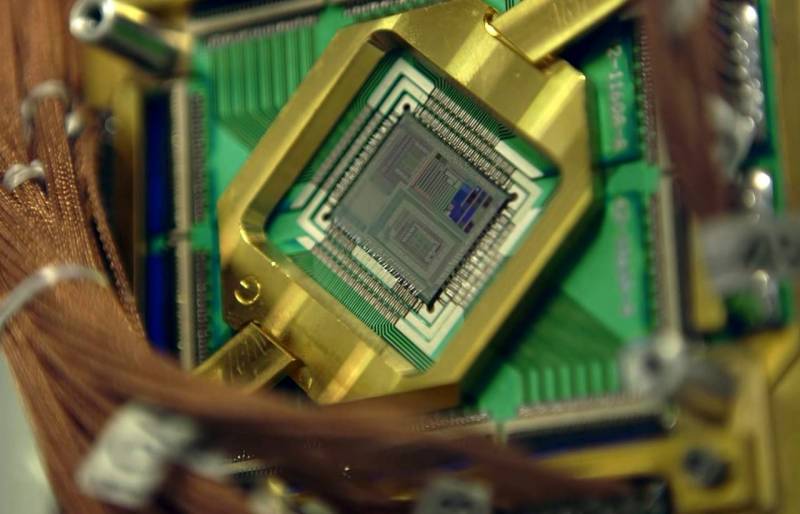Russia will have to cooperate with China in the production of microchips
According to US Deputy Secretary of Commerce Alan Estevez, Washington intends to limit Beijing's access to the most advanced microchips. To this end, pressure will be put on the two leading South Korean high-tech companies Samsung Electronics and Hynix, which have production facilities in China. The Americans are frankly forming a new "chip alliance" together with Taiwan, Japan and South Korea against China. What place can Russia take in this new world?
Semiconductor semi-sovereignty
China, which for several decades has become the "world factory", is the largest consumer of microchips, which are used in one way or another in all modern technology. Every year, Beijing bought $350 billion worth of semiconductors from American, Japanese and South Korean manufacturers.
An important nuance is that the geographically most significant enterprises are located in China: the Samsung Electronics plant operates in the city of Xi'an, and the world's third chip manufacturer, the South Korean Hynix, owns a plant in the Chinese city of Wuxi. In this case, it must be borne in mind that the most advanced, powerful microchips are made in Taiwan, which is under the tutelage of Uncle Sam. Now, when the air smells of a possible Chinese military operation against the rebellious island, all global players have begun to hastily import-substitute microchips, transferring their production to themselves, despite rising costs.
Mainland China has been doing the same thing for a very long time. Until 2025, Beijing has set the goal of achieving "semiconductor sovereignty." Huge amounts of money are being invested in import substitution, development and training of professional personnel in the PRC, so as not to remain on the technological sidelines. However, this task is very difficult, which determines the difficulties when trying to set a similar goal in our country. What exactly is the plug?
Difficulties of "chipization"
It cannot be said that Russia does not have any competencies and developments in the field of microelectronics. The first microprocessor appeared in the USSR in 1974, microcomputer - in 1979, personal computer "Electronics-85" - in 1985. In our country, there are enterprises Mikron, Angstrem-T, Baikal Electronics JSC, PKK Milandr JSC, MCST JSC, STC Module JSC, Elvis SPC JSC and a number of others involved in the development and production. But there are also important nuances.
The key point is the process by which the microchips are made: the fewer nanometers, the better. For understanding: the level of 180 nm was achieved by world technological leaders more than 20 years ago, 90 nm - more than 10 years ago, today they have reached 7 nm and even 3 nm. It took 30 years for Taiwan under the most favorable conditions to reach this level, and it holds 60% of the market, producing chips from 90 to 3 nm. Mainland China said last year that it had the necessary manufacturing capacity to mass-produce modern chips using the 14nm process. What do we have?
Zelenograd Mikron is a recognized leader in the field of Russian microelectronics. It has 180nm, 90nm and 65nm production technologies. Since 2018, the company has been planning to find investors to modernize production and master the 45-28 nm process technology, but these plans, alas, have not come true so far. JSC SPC "Elvis" in its developments has a portfolio of 50 chip types with production according to the technical process from 250 nm to 16 nm, and the most famous development of the company is the 28-nm processor "Skif". But this production was physically located in Taiwan, and TSMC stopped deliveries after the imposition of sanctions. According to some information, the construction of the NM-Tech plant is underway in Zelenograd, which will be able to produce chips using the 28-nm process technology.
The overall picture is clear. Russia will not remain completely without microchips, but there is a technological lag of several generations. Unfortunately, it will not be so easy to reschedule it at the behest of Putin. In order to create a competitive microelectronics industry, a combination of several factors is necessary.
At first, we need competent and well-trained personnel who will not flee abroad for higher salaries.
Secondly, we need modern high-tech equipment, the production of which is virtually monopolized, consumables and materials. Such equipment is being developed by the Netherlands (ASML), Japan (Nikon and Canon) and the USA (Applied Materials). Today, under the conditions of sanctions, it is not so easy to acquire all this. Since the “fat” decades have been mediocrely missed, now you can get something only through many intermediaries with the corresponding costs and restrictions.
ThirdlyIf we talk about the commercial component of such a project, it is desirable to have a capacious domestic market. Otherwise, such production will be initially and always subsidized. However, in a war this is acceptable.
What is left to do here and now?
First of all, one must be realistic and understand that a miracle will not happen and the modern Russian Federation alone will not create a competitive microelectronic industry. Therefore, it is necessary to go in several directions at once. On the one hand, it is necessary to obtain the required equipment by all possible means, miniaturize and at the same time scale production volumes. If it is possible to master the 28-nanometer processor mentioned above on our own, this must be done, and as soon as possible. On the other hand, it is necessary to try to cooperate with China by integrating into its production chain of more advanced 14-nm semiconductors and its accompanying "ecosystem" as at least a junior partner.
Finally, a comprehensive plan is needed for the development of Russian science, education and the reindustrialization of the country, since all these microchips are needed not by themselves, but in modern technology, both civilian and military.

Information